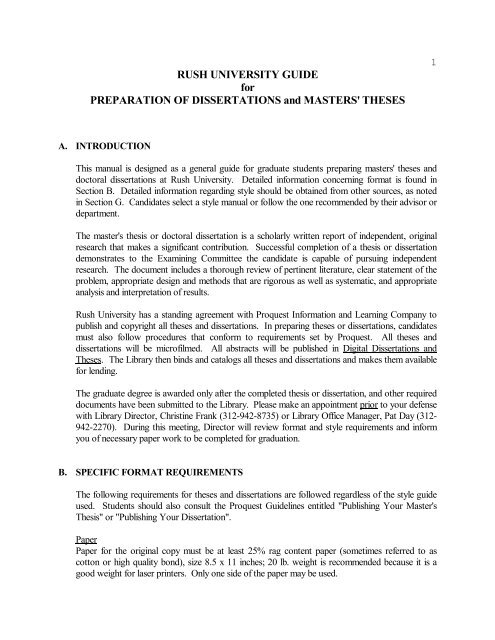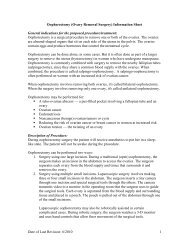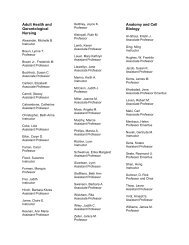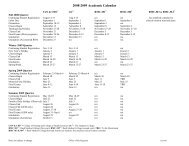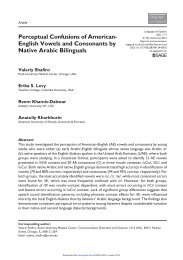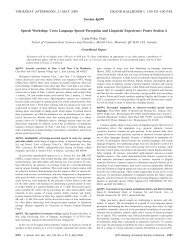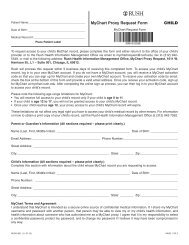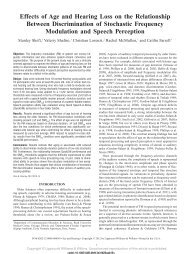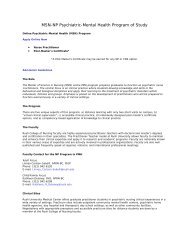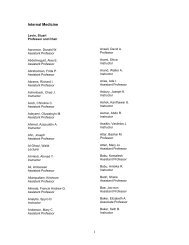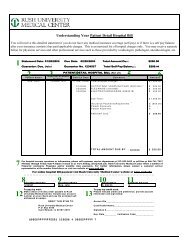RUSH UNIVERSITY GUIDE for PREPARATION OF ...
RUSH UNIVERSITY GUIDE for PREPARATION OF ...
RUSH UNIVERSITY GUIDE for PREPARATION OF ...
Create successful ePaper yourself
Turn your PDF publications into a flip-book with our unique Google optimized e-Paper software.
<strong>RUSH</strong> <strong>UNIVERSITY</strong> <strong>GUIDE</strong><br />
<strong>for</strong><br />
<strong>PREPARATION</strong> <strong>OF</strong> DISSERTATIONS and MASTERS' THESES<br />
1<br />
A. INTRODUCTION<br />
This manual is designed as a general guide <strong>for</strong> graduate students preparing masters' theses and<br />
doctoral dissertations at Rush University. Detailed in<strong>for</strong>mation concerning <strong>for</strong>mat is found in<br />
Section B. Detailed in<strong>for</strong>mation regarding style should be obtained from other sources, as noted<br />
in Section G. Candidates select a style manual or follow the one recommended by their advisor or<br />
department.<br />
The master's thesis or doctoral dissertation is a scholarly written report of independent, original<br />
research that makes a significant contribution. Successful completion of a thesis or dissertation<br />
demonstrates to the Examining Committee the candidate is capable of pursuing independent<br />
research. The document includes a thorough review of pertinent literature, clear statement of the<br />
problem, appropriate design and methods that are rigorous as well as systematic, and appropriate<br />
analysis and interpretation of results.<br />
Rush University has a standing agreement with Proquest In<strong>for</strong>mation and Learning Company to<br />
publish and copyright all theses and dissertations. In preparing theses or dissertations, candidates<br />
must also follow procedures that con<strong>for</strong>m to requirements set by Proquest. All theses and<br />
dissertations will be microfilmed. All abstracts will be published in Digital Dissertations and<br />
Theses. The Library then binds and catalogs all theses and dissertations and makes them available<br />
<strong>for</strong> lending.<br />
The graduate degree is awarded only after the completed thesis or dissertation, and other required<br />
documents have been submitted to the Library. Please make an appointment prior to your defense<br />
with Library Director, Christine Frank (3129428735) or Library Office Manager, Pat Day (312<br />
9422270). During this meeting, Director will review <strong>for</strong>mat and style requirements and in<strong>for</strong>m<br />
you of necessary paper work to be completed <strong>for</strong> graduation.<br />
B. SPECIFIC FORMAT REQUIREMENTS<br />
The following requirements <strong>for</strong> theses and dissertations are followed regardless of the style guide<br />
used. Students should also consult the Proquest Guidelines entitled "Publishing Your Master's<br />
Thesis" or "Publishing Your Dissertation".<br />
Paper<br />
Paper <strong>for</strong> the original copy must be at least 25% rag content paper (sometimes referred to as<br />
cotton or high quality bond), size 8.5 x 11 inches; 20 lb. weight is recommended because it is a<br />
good weight <strong>for</strong> laser printers. Only one side of the paper may be used.
2<br />
Margins<br />
A margin of one and a half inches (1.5") on the inner lefthand edge of the paper must be left to<br />
permit binding. Oneinch margins on the other three sides, except <strong>for</strong> page numbers, should<br />
normally be maintained.<br />
Spacing<br />
The manuscript must be doublespaced except <strong>for</strong> long quotations (4 or more lines), which are<br />
indented and singlespaced, and the List of References. Each reference in the list may be single<br />
spaced within the reference with two spaces between references.<br />
Running Heads<br />
Do not use running heads.<br />
Pagination<br />
Page numbers are placed at the upper right corner. The following plan of page numbering is<br />
required.<br />
1. For the preliminary pages use small Roman numerals (ii, iii, iv, etc.). Numbering begins with ii;<br />
the title page counts as page i but the number does not appear.<br />
2. For the remainder of the manuscript, beginning with the first page of Chapter 1, use Arabic<br />
numerals (1, 2, 3, 4, etc.) <strong>for</strong> the text, illustrations, list of references and appendices.<br />
Each page must be numbered. Numbering begins with 1 and runs consecutively to the<br />
end of the manuscript. If a table or figure is too long to be placed on a single page, it<br />
should be continued on the following numbered page.<br />
3. If there is more than one volume, each volume should contain a title page duplicating the title<br />
page of the first volume. If the volumes are separate entities it is important to identify<br />
them further as Volume I, II, etc. In any case, the numbering should follow<br />
consecutively from one volume to another.<br />
Order of Assembly<br />
Please see page 6 to see the order you must use to assembly the parts of your thesis or<br />
dissertation.<br />
Charts, Graphs, Tables<br />
Microfilming is a blackandwhite photographic process. Colors are to be avoided if at all possible<br />
because they appear as slightly varying shades of gray. Lines on a graph are identified by labels or<br />
symbols rather than color. Similarly, shaded areas as on histograms have better contrast if crosshatching<br />
is used instead of color. Charts, graphs, and tables are usually inserted in the text. If<br />
they take up a full page, locate them on the page as close to first mention of them in your text as<br />
you can. If they can fit between lines of text on a page, do so.<br />
Oversize Pages<br />
Charts, graphs, maps and tables larger than the standard page size might have to be used in a<br />
manuscript. If so, they should be carefully folded into the manuscript. However, oversize pages<br />
complicate microfilming and it is recommended that such pages be avoided unless absolutely<br />
necessary. Try a different layout <strong>for</strong> the chart or table to see if it can be placed on a standard page,
3<br />
or can it be divided into two pages and use a slight photographic reduction of the graphic material.<br />
If folds are necessary, make a few as possible.<br />
Photographs<br />
Ideally, each photograph should have a full range of contrast from true black to pure white.<br />
Photos with limited contrast will reproduce satisfactorily on positive microfilm, but they will be<br />
unclear in photocopies made from microfilm. Please avoid color photos if possible. If you need to<br />
use them please make sure your text includes enough in<strong>for</strong>mation about the color variation of any<br />
photos <strong>for</strong> the person reading your manuscript in a black and white reproduction. Photos may be<br />
scanned into the document.<br />
Title<br />
A thesis or dissertation may be a valuable source <strong>for</strong> scholars only if it can be located easily.<br />
Computer retrieval systems use the words in the title, and a few other descriptive words to locate<br />
a thesis or dissertation. It is essential that the title be a meaningful description of the content of the<br />
manuscript. Avoid oblique references and be sure to use word substitutes <strong>for</strong> <strong>for</strong>mulas, symbols,<br />
superscripts, subscripts, Greek letters, and so on. The <strong>for</strong>mat of the title page appears in<br />
Appendix A. Please make sure your title is identical on all the pages on which it appears: title<br />
page, approval page, abstract and copyright statement.<br />
Abstract<br />
The abstract of a dissertation must be no more than 350 words, counting just the text. For a<br />
master's thesis abstract the limit is 150 words or less of text. Format of the abstract page is<br />
included in Appendix A.<br />
A research abstract contains: 1. Statement of the problem; 2. Procedure or methods; 3. Results; 4.<br />
Conclusions.<br />
Symbols, <strong>for</strong>eign words and phrases must be printed clearly and accurately to avoid errors.<br />
Mathematical <strong>for</strong>mulas, diagrams, and other illustrative materials are not recommended <strong>for</strong> the<br />
abstract.<br />
List of References<br />
The List of References appears after the body of the thesis or dissertation and be<strong>for</strong>e any<br />
appendices. All references must be prepared according to the guidelines of the chosen style<br />
manual. Journal titles may be written in full or abbreviated. Either abbreviate all references or<br />
write them all out. Do not mix them. If they are abbreviated only standard abbreviations from<br />
indexes such as Medline, Biological Abstracts or Psychological Abstracts may be used.<br />
C. USE <strong>OF</strong> COPYRIGHTED MATERIAL<br />
Authors of masters' theses and dissertations assume full responsibility <strong>for</strong> use of any copyright<br />
material in their manuscripts. A copyright statement is signed by the author and placed at the end<br />
of the completed thesis or dissertation. Format and content of this statement appears in Appendix<br />
A. It must be signed and dated.<br />
The candidate must obtain written permission from the author to quote extensively or to
4<br />
reproduce tables, figures, graphs or charts from unpublished copyrighted material. If a previously<br />
published questionnaire, table, figure or other material is to be used in the candidate's research,<br />
written permission must be obtained, in most cases, from the publisher. In a few cases the author<br />
holds the copyright. Written permission which gives permission specifically to use and reproduce<br />
the material must be obtained be<strong>for</strong>e including it in a thesis or dissertation. The candidate keeps<br />
the original permission letters as questions regarding permission to use copyrighted material may<br />
arise at a later date. However, copies of the letters of permission must be submitted with the<br />
thesis or dissertation to University Microfilms. Receipt of permission is acknowledged by citing<br />
the material according to the chosen style guide, and the statement: Used with permission of the<br />
publisher (or author). Customarily, permission is granted on the condition that proper<br />
acknowledgement is given. The citation appears in the List of References and on the copyrighted<br />
material if it is to be included in the document.<br />
Copyright of theses and dissertations<br />
Proquest files copyright applications with the Library of Congress <strong>for</strong> all Rush University masters'<br />
theses and dissertations. There is a fee <strong>for</strong> the application. The Dissertation Coordinator will<br />
provide students with a current price list.<br />
D. COORDINATOR <strong>OF</strong> PUBLICATION <strong>OF</strong> THESIS AND DISSERTATION<br />
Definition of Role<br />
The Coordinator advises on all details regarding <strong>for</strong>mat and style and reviews the final copy of the<br />
master's thesis or dissertation <strong>for</strong> publication by Proquest. The Coordinator is the Library<br />
Director.<br />
The Coordinator also provides in<strong>for</strong>mation about the procedure <strong>for</strong> acceptance and publication of<br />
masters' theses and doctoral dissertations. Each student receives a brochure that covers the<br />
following: 1. Application <strong>for</strong> microfilming, publishing and copyrighting; 2. Statement of current<br />
charges; and 3. List of instructions <strong>for</strong> completing necessary paperwork.<br />
Review <strong>for</strong> Format and Style<br />
The student is requested to submit to the Coordinator a draft of the thesis or dissertation prior to<br />
preparing the final copy. The Coordinator reviews the draft <strong>for</strong> compliance with the requirements<br />
in this "Guide" and with the style manual selected by the student. Areas examined include <strong>for</strong>mat,<br />
style, table of contents, page numbering system, arrangement of chapters, list of references,<br />
illustrations, tables, figures, copyright in<strong>for</strong>mation, and copyright statement. The Coordinator<br />
only accepts paper copies of drafts; electronic versions of manuscripts will not be accepted.<br />
Obtaining additional bound copies<br />
Students who wish to have additional copies bound by the Library's binding vendor may do so at<br />
their own expense. Contact the Library's Technical Services Manager at 9422276 <strong>for</strong> in<strong>for</strong>mation<br />
about this service. Other options <strong>for</strong> binding include commercial printers or Proquest itself.
E. CHECK LIST <strong>OF</strong> PROCEDURES REGARDING THESIS AND DISSERTATION<br />
SUBMISSION<br />
1. Make an appointment with the Coordinator/Library Director be<strong>for</strong>e your defense to obtain<br />
Proquest in<strong>for</strong>mation and review <strong>for</strong>mat and style requirements.<br />
Then, after thesis or dissertation has been accepted and grades have been sent to the Registrar:<br />
2. Complete the Proquest Master's Thesis or Dissertation Agreement <strong>for</strong>m.<br />
3. Obtain letter from the University Registrar certifying the degree received and the date on which<br />
it was awarded.<br />
4. Obtain degree approval <strong>for</strong>m from Registrar.<br />
5. Bring to the Library the following:<br />
a. The original copy of the approved thesis or dissertation, (on 25% rag bond paper, 20 lb.<br />
weight) in loose sheets<br />
b. An extra title page (on any type of paper)<br />
c. An extra abstract (on any type of paper)<br />
d. The completed Thesis/Dissertation Agreement<br />
e. Letter and degree approval <strong>for</strong>m from Registrar<br />
f. A money order covering all fees (see Proquest price list in Brochure <strong>for</strong> current Publishing<br />
Service Price List)<br />
g. Five dollars cash or personal check payable to The Library of Rush University <strong>for</strong> mailing<br />
charges<br />
6. The Library will send the original thesis or dissertation to Proquest.<br />
7. After Proquest films it, the thesis or dissertation will be returned to the Library along with a<br />
microfiche copy. The Library will bind and catalog it, add it to the collection and lend it on<br />
request.<br />
8. The Library will bind additional copies at the current binding rate if requested. However, there<br />
are many other commercial binders as well who can provide this service.<br />
5
6<br />
F. DISSERTATION ORDER <strong>OF</strong> ASSEMBLY<br />
Blank page<br />
*Title Page<br />
Preliminary Pages:<br />
*Approval Page<br />
*Abstract (lower case)<br />
Preface or Forward (if any)<br />
Dedication (if any)<br />
Acknowledgement (if any)<br />
Table of Contents<br />
List of Tables (if any)<br />
List of Figures (if any)<br />
Lists of other types of materials:<br />
(photographs, etc.)<br />
Body of Text<br />
List of References<br />
(unnumbered)<br />
(unnumbered but counted as<br />
as page i)<br />
(Paginate all subsequent<br />
preliminary pages using<br />
lower case Roman<br />
numerals beginning with<br />
ii, iii etc.)<br />
(Paginate body of text using<br />
Arabic numerals beginning<br />
with 1)<br />
Appendices (if any)<br />
*Copyright Statement<br />
(unnumbered)<br />
Blank page<br />
* Required <strong>for</strong>mat <strong>for</strong> these pages are provided in Appendix A.
G. <strong>GUIDE</strong>S FOR FORMAT & STYLE AVAILABLE IN THE LIBRARY<br />
(Check the online catalog, RushCAT <strong>for</strong> call number and location.)<br />
7<br />
American Psychological Association. (2001). Publication manual (5th Ed.). Washington, D.C.: APA.<br />
Please note Section 6 covers theses and dissertations. The rest of the manual is more concerned with<br />
preparation of journal articles. Also, Section 4 includes reference <strong>for</strong>mats <strong>for</strong> electronic materials. If<br />
you have questions regarding style, please contact the Thesis/Dissertation Coordinator at 312942<br />
8735.<br />
Patrias, Karen. National Library of Medicine Recommended Formats <strong>for</strong> Bibliographic Citation<br />
(Online). Bethesda, MD: U.S. Department of Health and Human Services, Public Health Service,<br />
National Institutes of Health, National Library of Medicine, Reference Section.<br />
http://www.nlm.nih.gov/pubs/<strong>for</strong>mats/internet.pdf see especially pages 524.<br />
American Psychological Association.<br />
Association. 5th ed. Washington, DC<br />
Publication Manual of the American Psychological<br />
Browner, Warren S., Publishing and Presenting Clinical Research. Baltimore: Lippincott Williams<br />
& Wilkins, 1999.<br />
Fondiller, Shirley H., The Writer's Workbook. Sudbury, MA: Jones and Bartlett Publishers,<br />
1999.<br />
Huth, Edward J., Writing and Publishing in Medicine. 3rd ed. Baltimore: Williams & Wilkins,<br />
1999.<br />
Iverson, Cheryl., American Medical Association Manual of Style. 9th ed. Baltimore: Williams &<br />
Wilkins, 1998.<br />
Mauch, James E., Guide to the Successful Thesis and Dissertation. 4th ed., rev. and expanded.<br />
New York: M. Dekker, 1998.<br />
Pyrczak, Fred., ed. Completing Your Thesis or Dissertation. Los Angeles, CA: Pyrczak Pub,<br />
2000.<br />
Pyrczak, Fred., Writing Empirical Research Reports. 3rd ed. Los Angeles, CA: Pyrczak Pub,<br />
2000.<br />
Sides, Charles H., How to Write & Present Technical In<strong>for</strong>mation. 3rd ed. Phoenix, Ariz: Oryx<br />
Press, 1999.<br />
Zeiger, Mimi., Essentials of Writing Biomedical Research Papers. 2nd ed. New York: McGraw<br />
Hill, Health Professions Division, 2000.<br />
Zuckerman, Edward L., Clinician's Thesaurus. 5th ed. New York: Guil<strong>for</strong>d Press, 2000.
APPENDIX A: Format <strong>for</strong> Title Page,<br />
Approval Form, Abstract and Copyright Statement<br />
8
9<br />
TITLE <strong>OF</strong> (DISSERTATION OR THESIS)<br />
by<br />
Candidate's Full Name<br />
B.S., University of __________, 20__<br />
M.S., University of __________, 20__<br />
Submitted to Rush University in partial<br />
fulfillment of the requirements <strong>for</strong> the<br />
degree of (degree)<br />
Master of Science<br />
or<br />
Doctor of Philosophy<br />
or<br />
Master of Arts<br />
[<strong>for</strong> Health Care Ethics students only]<br />
(c) Copyright by (Candidate's full legal name), 20__<br />
All Rights Reserved
(DISSERTATION OR THESIS) APPROVAL FORM<br />
10<br />
The undersigned have examined the (dissertation or thesis) entitled:<br />
presented by:<br />
a candidate <strong>for</strong> the degree of<br />
Master of Science<br />
or<br />
Doctor of Philosophy<br />
or<br />
Master of Arts<br />
[<strong>for</strong> Health Care Ethics students only]<br />
and hereby certify that in their judgement it is worthy of acceptance.<br />
(signature)<br />
(signature)<br />
_________________________________<br />
_________________________________<br />
*Name (Chairperson) (date) Name (date)<br />
Rank<br />
Department<br />
University<br />
Rank<br />
Department<br />
University<br />
(signature)<br />
(signature)<br />
_____________________________________ _________________________________<br />
Name (Chairperson) (date) Name (date)<br />
Rank<br />
Department<br />
University<br />
Rank<br />
Department<br />
University<br />
* NOTE: Please make only as many spaces <strong>for</strong> signatures and advisor in<strong>for</strong>mation as you have<br />
advisors!
11<br />
ABSTRACT<br />
Title (of Thesis or Dissertation):<br />
Mary Smith, (degree), 20__<br />
(Thesis or Dissertation) directed by: (Give name of major research advisor, academic rank and name of<br />
department or program.)<br />
____________________________________________<br />
Signature of (Thesis or Dissertation) Advisor<br />
(Body of abstract is doublespaced and should not exceed 350 words <strong>for</strong> dissertation or 150 words <strong>for</strong><br />
thesis)
12<br />
COPYRIGHT STATEMENT *<br />
I hereby guarantee that no part of the (dissertation or thesis) entitled, (underline title), which I have<br />
submitted <strong>for</strong> publication, has been copied from a copyrighted work, except in cases of passages<br />
properly quoted from a copyrighted work, copied with permission of the author, or copied from a<br />
work in which I own the copyright; that I am the sole author and proprietor of the (dissertation or<br />
thesis); that the (dissertation or thesis) in all respects complies with the Copyright Revision Act of<br />
1976; that the (dissertation or thesis) contains no matter which, if published, will be libelous or<br />
otherwise injurious to, or infringe in any way the copyright of any other party; and that I will defend,<br />
indemnify and hold harmless Rush University Medical Center against all suits and proceedings which<br />
may be brought and against all claims which may be made against Rush University Medical Center by<br />
reason of the publication of the (dissertation or thesis).<br />
___________________________________________________________________________<br />
Date<br />
Author's Signature<br />
* Please just type this in<strong>for</strong>mation as it is. This page follows your thesis or dissertation. It is not a<br />
part of it and does not have a page number.


